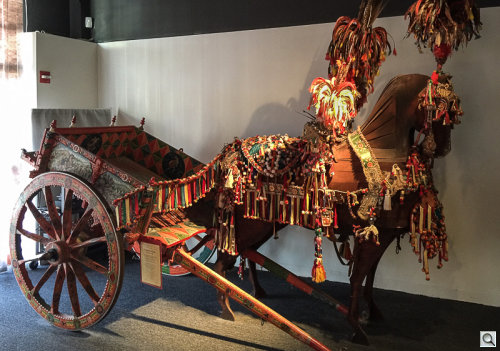Photo Corners headlinesarchivemikepasini.com
![]()
A S C R A P B O O K O F S O L U T I O N S F O R T H E P H O T O G R A P H E R
![]()
Enhancing the enjoyment of taking pictures with news that matters, features that entertain and images that delight. Published frequently.
Friday Slide Show: Il Carretto Siciliano




8 January 2016
Manfedi Polizzi, himself a native of Sicily, somehow transported this caretto to California in 1985. His widow Lee donated it to San Franisco's Museo Italo-Americano in his honor in 1988. You can find it today in the Museo's library at Fort Mason.
The cart also includes the finimenti, a harness for the horse with tassels, brightly color features and all the trimmings.
And that harness has been placed on the horse Ermengarda, designed and created by Paula Pisano Cohen with help from Gordon Holt.
A fact sheet hanging on the cart itself tells its story:
The cart was built and decorated in a floriated, rustic style in the early 1920s. It is in its orignal condition, except for the section underneath, which has been repainted. It was renovated in 1985 when it was outfitted with new trappings for the horse and a new axel assemblage. The side panels, painted by the Sicilian folk artist Tano Ferrara from Aci S. Antonio (Catania), depict the battles of the Christian Crusaders Fioravante, Rizieri, Fiovo, Grifone and Aquilante against the Sarazens.
The two panels on the side visible in our shots of the cart depict scenes from Rizieri's life.
CARRETTI
Sicilian carts typically are constructed with about 60 parts of wood, iron and brass handcrafted by cartwrights, woodworkers, painters, ironsmiths and other skilled artisans. Military conquests and opera scenes are the subjects most often painted on the side panels.
Introduced to Sicily by the ancient Greeks, the carts reached the height of their popularity in the 1920s, each Sicilian province building them in their own style. Carretti made in the province of Palermo, for example, favor a square design for the bed. In Catania they are made with elaborate keys while the carretti in Agrigento have a style all their own.
The trucks of their day, carretti were used for many things. Carretti del Lavoro were used for work, carrying people, wine, produce, wood and anything else that had to be taken from one place to another. Show carts or Carretto di Garra were used for special occasions. Horses pulled the carts in the cities, donkeys in the rough hilly countryside.
Every carretto has two wheels and each wheel has twelve spokes, six curves of wood and one center hub called da mieolo, made of walnut and bound by two metal rings on a metal hub. The wheel is fixed to the metal shaft by a nut or rannola that screws onto the axel to hold the wheel to the shaft.
THE IMAGES
The library is tucked into a corner of the Museo Italo-Americano and is often closed. But the day we were there, the door was open so we peeked inside. Nobody was around.
We slipped our iPhone 6 Plus out of our pocket and, using the Obscura camera app, took a few shots of the carretto, letting the iPhone worry about the mixed lighting. There was sunlight from the window behind the cart and stage lighting illuminating it.
Back at the bunker, we imported the set of images into Lightroom. As JPEGs they didn't have much headroom for editing tone or color but we did manage to crop and sharpen them. And, in the case of the first image, we even used the Upright tool to minimize the iPhone's wide angle distortion.
It helped, of course, but you can't pretend it's a horse when your cart is being pulled by a donkey.
